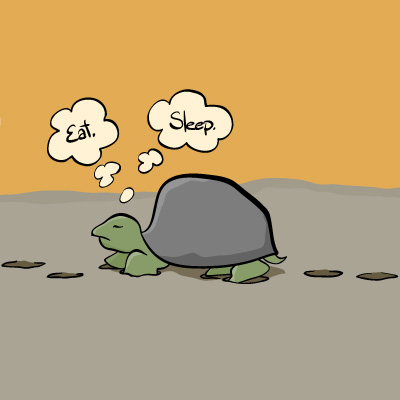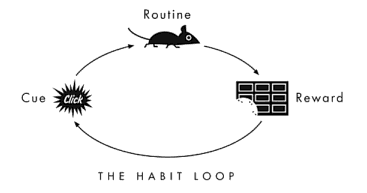
There is a structure behind every habit which psychologists refer to as a “habit loop.” By understanding our “habit loops,” we can more easily change our behaviors. Here’s how to do it!
Behind every habit there is a structure.
Psychologists refer to these as “habit loops.” And according to Charles Duhigg’s great book The Power of Habit: Why We Do What We Do in Life and Business, habit loops consist of three main parts.
First is the cue, the trigger from the environment that tells your brain to go into autopilot and which habit to use. Next is the routine, which can be a mental or physical action you take whenever presented with the cue. And lastly is the reward, which is what you get from the habit that fulfills a craving in your brain.
When this pattern of “cue-routine-reward” gets repeated many times it becomes more and more automatic. This is because the more we repeat it, the more it gets wired into our brains (in neuroscience, this is called “long-term potentiation.”) However, by better understanding habit loops, we can more easily disrupt the cycle and rewire our brains to new habits.

For example, let’s say everyday after dinner you sit on your couch to watch TV while eating a carton of ice cream. It’s a nasty habit – and it’s probably the reason you’ve gained 25 pounds over the past few months. However, no matter how hard you try to break the habit you can’t seem to change it.
What you need to do is identify your habit loop. What is the routine that you want to change? What are the cues triggering you to do that routine? And what are the rewards you are getting as a result of that routine? By better understanding the cycle of “cue-routine-reward” you can more easily modify your behavior.
Find the Cue: What Triggers Your Habit?
A cue is a stimulus from your environment that triggers you to do your routine. Often we have trouble identifying cues because there is so much unconscious information that motivates our habits.
For example, do you eat dinner a certain time each day because you are hungry? Or because the clock says 630PM? Or because your children start asking for dinner? Or because you’re home from work, and that’s just when your dinner routine begins?
Psychologists have identified different categories of habitual cues that often trigger our habit loops. These are:
-
Location – Where are you when your habit loops are triggered?
Time – What time of the day is it?
Mood – What’s your emotional state?
Thoughts – What are you thinking?
People around you – Who is around you when you act out these habits?
Immediately preceding action – What do you do right before the habit starts?
Once we understand the cues that trigger our habit loops, we can use that insight to modify our behaviors.
For example, say you’re an alcoholic whose habits are triggered by your location (party, bar, or club) or the people you are with (friends who love drinking). One way you can try to disrupt your habit loop is by avoiding places or people that motivate you to drink.
Find the Reward: Can You Substitute It?
Once you find the cue that triggers your behavior, you can experiment with different rewards to see what your brain is actually craving.
Let’s go back to the example of you eating ice cream while watching TV. By trying out different rewards you can see what it is you get from the activity. Are you eating ice cream because you’re hungry? Are you just bored and it’s a way to pass the time? Or maybe it’s something you do to socialize with family or roommates?
There are a number of reasons we may build a certain habit, but it’s not always clear why we do the things we do. By experimenting with different rewards, you can discover what it is you are really getting out of your routine.
It may take a couple weeks before you discover what it is your brain is craving. Maybe the first day you experiment with eating a salad, but afterwards you still feel an urge for ice cream. This suggests that the reward you’re getting is probably not related to hunger.
Next you might try socializing with the family in a different way, such as playing a video game together instead of eating ice cream together. After this activity maybe you find that your craving for ice cream goes away. If that’s the case, your routine of “eating ice cream” may be a result of your desire to connect with your family.
This is just one example, but hopefully you get the idea. People do things for many different reasons, but experimenting with different rewards can help us find what it is our brains actually want fulfilled. If we understand that, we can replace our old habit loops with new habit loops that still fulfill the rewards we want.
Make a Plan to Change Habit Loops: “If, Then” Statements
Once you identify the “cue-routine-reward” behind your habit loops, it becomes much easier to make a plan on how to change them.
Psychologists have found compelling research that making a plan to act in a certain way at a certain time and place makes it much more likely that we will commit to these new behaviors. These are called implementation intentions.
The basic idea is to form an if-then plan to help instill new habits. Write down and repeat your plan, such as, “If situation X arises, I will perform response Y.” X refers to the cue from your environment. Y refers to the new routine you want to replace with the old routine.
You’ll probably make some mistakes along the way. Maybe some days you’ll miss your cue. Maybe other days you’ll find it easier to just resort to your old habit. It’s reasonable to expect that it’s going to take some practice before your new habit loop is set in motion.
As Charles Duhigg writes…
-
“Habits aren’t destiny — they can be ignored, changed or replaced. But it’s also true that once the loop is established and a habit emerges, your brain stops fully participating in decision-making. So unless you deliberately fight a habit — unless you find new cues and rewards — the old pattern will unfold automatically.”
Simply understanding how habits work makes this process easier. However, there will always be some self-discipline and patience needed to get the results you want. Don’t be too hard on yourself if you stumble a bit along the way. Remember, you’re trying to do something that is ultimately going to rewire your brain.
Enter your email to stay updated on new articles in self improvement:
